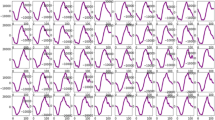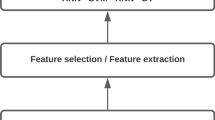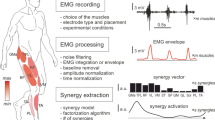Abstract
Pattern recognition using myoelectric control of upper-limb prosthetic devices is essential to restore control of several degrees of freedom. Although much development has been relevant, the prediction of force level in finger movements is scanty. In this study, we propose the surface electromyography (sEMG) to predict the force level of the thumb-index pinch. Ten non-amputee subjects are asked to do five force levels with three different wrist positions and five object lengths. The sEMG data are recorded from three muscle regions (12 channels) of the right forearm. Twelve traditional time-domain features are extracted from collected sEMG signal. The sequential forward floating selection (SFFS) method is investigated to find the optimal set of muscles and features for force prediction. Performances from seven linear and nonlinear classifiers are compared. The results show that k-nearest neighbor and neural network outperform other classifiers with the accuracy of about 99% and 97%, respectively. The accuracy from the set of muscle groups and features selected by SFFS method is slightly better than that from the set of baseline (all of channels and features). The frequently selected muscles are from the hand region. However, the combination of lower and upper muscles also performs well, which is useful for the prosthetic design in a hand and wrist disarticulation amputee and a transradial amputee in the future.









Similar content being viewed by others
References
Resnik, L., Meucci, M.R., Lieberman-Klinger, S., Fantini, C., Kelty, D.L., Disla, R., Sasson, N.: Advanced upper limb prosthetic devices: implications for upper limb prosthetic rehabilitation. Arch. Phys. Med. Rehabil. 93, 710–717 (2012)
Geethanjali, P.: Myoelectric control of prosthetic hands: state-of-the-art review. Med. Devices (Auckl) 9, 247–255 (2016)
Al-Jumaily, A., Olivares, R.A.: Bio-driven system-based virtual reality for prosthetic and rehabilitation systems. Signal Image Video Process. 6, 71–84 (2012)
Kakoty, N.M., Saikia, A., Hazarika, S.M.: Exploring a family of wavelet transforms for EMG-based grasp recognition. Signal Image Video Process. 9, 553–559 (2015)
Kamavuako, E.N., Farina, D., Yoshida, K., Jensen, W.: Relationship between grasping force and features of single-channel intramuscular EMG signals. J. Neurosci. Methods 185, 143–150 (2009)
He, J., Zhang, D., Sheng, X., Li, S., Zhu, X.: Invariant surface EMG feature against varying contraction level for myoelectric control based on muscle coordination. IEEE J. Biomed. Health Inform. 19(3), 874–882 (2015)
Kilic, E.: EMG based neural network and admittance control of an active wrist orthosis. J. Mech. Sci. Technol. 31(12), 6093–6106 (2017)
Al-Timemy, A.H., Khushaba, R.N., Bugmann, G., Escudero, J.: Improving the performance against force variation of EMG controlled multifunctional upper-limb prostheses for transradial amputees. IEEE Trans. Neural Syst. Rehabil. Eng. 24(6), 650–661 (2016)
Celadon, N., Došen, S., Binder, I., Ariano, P., Farina, D.: Proportional estimation of finger movements from high-density surface electromyography. J. Neuroeng. Rehabil. 13, 73 (2016)
Adewuyi, A.A., Hargrove, L.J., Kuiken, T.A.: Evaluating EMG feature and classifier selection for application to partial-hand prosthesis control. Front. Neurorobot. 19, 10–15 (2016)
Theodoridis, S., Koutroumbas, K.: Pattern Recognition. Academic Press, London (2006)
Pudil, P., Novovičová, J., Kittler, J.: Floating search methods in feature selection. Pattern Recognit. Lett. 15(11), 1119–1125 (1994)
Thongpanja, S., Phinyomark, A., Quaine, F., Laurillau, Y., Limsakul, C., Phukpattaranont, P.: Probability density functions of stationary surface EMG signals in noisy environments. IEEE Trans. Instrum. Meas. 65(7), 1547–1557 (2016)
Oskoei, M.A., Hu, H.: Myoelectric control systems—a survey. Biomed. Signal Process. Control 2(4), 275–294 (2007)
Arjunan, S.P., Kumar, D.K.: Decoding subtle forearm flexions using fractal features of surface electromyogram from single and multiple sensors. J. Neuroeng. Rehabil. 7, 53 (2010)
Jain, A.K., Duin, R.P.W., Mao, J.: Statistical pattern recognition: a review. IEEE Trans. Pattern Anal. Mach. Intell. 22, 4–37 (2000)
Rokach, L., Maimon, O.: Top-down induction of decision trees classifiers—a survey. IEEE Trans. Syst. Man Cybern. Part C Appl. Rev. 35(4), 476–487 (2005)
Aydemir, O., Kayikcioglu, T.: Investigation of the most appropriate mother wavelet for characterizing imaginary EEG signals used in BCI systems. Turk. J. Electr. Eng. Comput. Sci. 24, 38–49 (2016)
Altin, C., Er, O.: Designing wearable joystick and performance comparison of EMG classification methods for thumb finger gestures of joystick control. Biomed. Res. 28(11), 4730–4736 (2017)
Vapnik, V.N.: Statistical Learning Theory. Wiley, New York (1998)
Mccue, R.: A comparison of the accuracy of support vector machine and Naïve Bayes algorithms in spam classification. University of California at Santa Cruz, CA, Nov 2009
Scholkopf, B., Sung, K.K., Burges, C.J., Girosi, F., Niyogi, P., Poggio, T., Vapnik, V.: Comparing support vector machines with Gaussian kernels to radial basis function classifiers. IEEE Trans. Signal Process. 45(11), 2758–2765 (1997)
Ding, Y., Pardon, M.C., Agostini, A., Faas, H., Duan, J., Ward, W.O.C., Easton, F., Auer, D., Bai, L.: Novel methods for microglia segmentation, feature extraction and classification. IEEE ACM Trans. Comput. Biol. Bioinform. 14(6), 1366–1377 (2017)
Cover, T., Hart, P.: Nearest neighbor pattern classification. IEEE Trans. Inf. Theory 13, 21–27 (1967)
Borgelt, C., Timm, H., Kruse, R.: Probabilistic networks and fuzzy clustering as generalizations of Naive Bayes classifiers. In: Reusch, B., Temme, Karl-Heinz (eds.) Computational Intelligence in Theory and Practice. Advances in Soft Computing, pp. 121–138. Physica, Heidelberg (2001)
Tang, Z., Yu, H., Cang, S.: Impact of load variation on joint angle estimation from surface EMG signals. IEEE Trans. Neural Syst. Rehabil. Eng. 24(12), 1342–1350 (2016)
Choi, C., Kwon, S., Park, W., Lee, H., Kim, J.: Real-time pinch force estimation by surface electromyography using an artificial neural network. Med. Eng. Phys. 32(5), 429–436 (2010)
Lee, S.K., Wisser, J.R.: Restoration of pinch in intrinsic muscles of the hand. Hand Clin. 28, 45–51 (2012)
Riillo, F., Quitadamo, L.R., Cavrinia, F., Gruppioni, E., Pinto, C.A., Pastò, N.C.: Optimization of EMG-based hand gesture recognition: supervised vs. unsupervised data preprocessing on healthy subjects and transradial amputees. Biomed. Signal Process. Control 14, 117–125 (2014)
Malešević, N., Marković, D., Kanitz, G., Controzzi, M., Cipriani, C., Antfolk, C.: Vector autoregressive hierarchical hidden Markov models for extracting finger movements using multichannel surface EMG signals. Complexity 1, 1–12 (2018)
Lu, W., Duan, J., Qiu, Z., Pan, Z., Liu, R.W., Bai, L.: Implementation of high-order variational models made easy for image processing. Math. Methods Appl. Sci. 39(14), 4208–4233 (2016)
Mohan, N., Kumar, S., Poornachandran, P., Soman, K.P.: Modified variational mode decomposition for power line interference removal in ECG signals. Int. J. Electr. Comput. Eng. 6(1), 151–159 (2016)
Acknowledgements
This work was jointly funded by the Thailand Research Fund and Faculty of Engineering, Prince of Songkla University through Contract No. RSA5980049, in part by the Higher Education Research Promotion and National Research University Project of Thailand, Office of the Higher Education Commission. This research was also supported by the Postdoctoral Fellowship from Prince of Songkla University.
Author information
Authors and Affiliations
Corresponding author
Additional information
Publisher's Note
Springer Nature remains neutral with regard to jurisdictional claims in published maps and institutional affiliations.
Rights and permissions
About this article
Cite this article
Jitaree, S., Phukpattaranont, P. Force classification using surface electromyography from various object lengths and wrist postures. SIViP 13, 1183–1190 (2019). https://doi.org/10.1007/s11760-019-01462-z
Received:
Revised:
Accepted:
Published:
Issue Date:
DOI: https://doi.org/10.1007/s11760-019-01462-z




